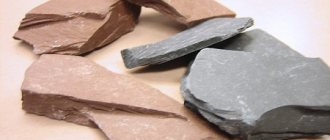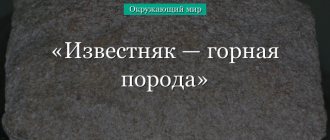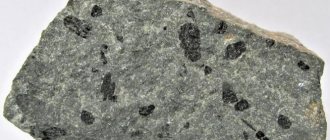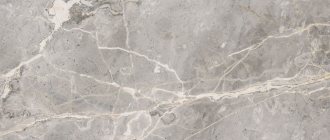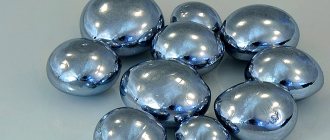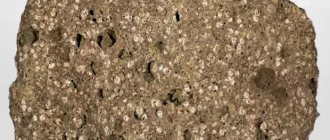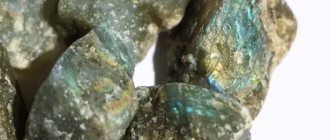| Category | Igneous rocks |
| Title in English | Pegmatite |
| Formula | SiO2 |
| Group | Group of polyspars |
| Color | Light grey, Yellowish, Pale pink, Meat red |
| Stroke color | Absent |
| Shine | Glass |
| Transparency | Opaque |
| singonia | Absent |
| Hardness | 6,5 — 7,5 |
| Cleavage | Absent |
| Density, g/cm³ | 2,5 — 2,7 |
| Kink | Conchoidal |
| origin of name | The name pegmatite was given to pegmatite in 1801 by the famous French mineralogist Rene-Juste Haüy. Thus, the scientist designated a name for graphic pegmatite, which is also known by the names “Jewish stone” and “written granite.” The term pegmatite was formed due to a special characteristic of the mineral - quartz closely grows with spar, forming a pegmatite structure. |
Pegmatite is a subtype of rock that is widespread on our planet. It is of igneous origin, and is found in the earth's crust as veins, cells, and nests. According to the depth of occurrence, pegmatites are distinguished: small, medium, large and extra-large depths. The depth of pegmatite is sometimes measured in kilometers. The thickness of such deposits ranges from a couple of centimeters to tens of meters.
Pegmatite deposits
Pegmatite is ubiquitous.
Its industrial production is carried out in Brazil, Norway, Sweden, Karelia, the Kola Peninsula, the Irkutsk region, Eastern Kazakhstan, the Ilmen and Cherry Mountains, and Ukraine. A well-known decorative variety of granite pegmatites, “written granite,” is mined in Russia (Urals, Karelia, Irkutsk region). — Advertising —
Pegmatite veins occur in large groups with the formation of large pegmatite fields. They are usually developed by open casting using industrial methods.
Written granite
Gem lovers know pegmatite in the form of written granite - an unusual ornamental stone, the crystals of which resemble letters that conceal ancient wisdom.
In Scandinavia it is called a rune stone. Perhaps the stone patterns inspired the harsh Vikings to create runic writing.
Northern peoples considered stones with incomprehensible signs to be sacred, marked with the seal of spirits.
In Russia, written granite was called Jewish stone, for the simple reason that the Russians did not know another language with similar writing of letters.
Written granite
This is interesting! In the book by A.E. Fersman describes a stone found in the Urals with lines that very accurately repeated the writing of letters in Yiddish. Some letters could even be combined into syllables and some words. They believed in the natural origin of the mysterious inscriptions when they discovered that the letters were not written on the surface of the stone, but penetrated its thickness.
Written granite belongs to ceramic pegmatites and is found quite often. Of course, there are much more simple “grouse grouse” than stones with exquisite and intriguing designs. Karelian and Scandinavian deposits are famous for their beautiful specimens. In France, a stone with black writing on a white background is mined.
Also read: Kyanite is a symbol of fidelity and prudence
It is important to cut the written granite at the right angle so that the dark “streams” penetrating the lighter massif appear on the surface in the form of mysterious signs. Otherwise you’ll just end up with a cute striped pebble.
History of pegmatite
The name "pegmatite" came into use at the beginning of the 19th century, and was proposed by the French mineralogist R. J. Gayuy.
This term is translated from Greek as “fastening” or “connection.” It indicates the coarse-crystalline igneous nature of this rock. Pegmatites are billions of years old. At its core, this rock is the same age as the earth’s crust. People have also known her for quite a long time. In addition, pegmatites are very diverse. In industry, for example, the rare earth variety, which contains rare earth metals, is important. It is interesting because it contains more than 500 different minerals, including a large number of compounds of lithium, beryllium, tantalum, bismuth, cesium, and rubidium. Such deposits are found in nature at depths from 4 to 7 km.
Quite large crystals of other minerals are often found in pegmatites - very spectacular, of unusual shape and size. Such specimens are interesting both for science and in jewelry.
Origin
The formation of pegmatite began at a time when the earth was a young planet. The earth's crust was just forming. When it burst, molten magma poured into the cracks and solidified to form pegmatites. The reason for their diversity in composition and structure is that they differed greatly:
- magma composition;
- depth of cracks;
- melt crystallization time;
- temperature of pegmatite formation ( from 650–700 to 400 oC ).
Mineralizing components (water, chlorine, fluorine, bromine, etc.) actively participated in the formation of these minerals.
Physico-chemical characteristics of pegmatite
— Advertising —
Pegmatite is mainly composed of silica and other minerals. This rock is characterized by the presence of large and gigantic crystals located zonally in it. Locally, the composition of pegmatite may be dominated by minerals with a high content of highly volatile components, such as water, fluorine, chlorine, boron, and carbon dioxide. In general, the mineral composition is very diverse, it includes lithium, rubidium, cesium, beryllium, niobium, tantalum, zirconium, hafnium, thallium, uranium, scandium and other rare elements.
The color palette of pegmatites includes shades of pink, reddish, light gray, and yellowish.
Pegmatite is characterized by a holocrystalline or giant-grained structure. It can form germinations of feldspar with quartz grains, the so-called “graphic” structure. The presence of eutectoid texture and layer separation is also characteristic. The density of pegmatite is 2.5-2.7 g/cm3.
Who is suitable according to their zodiac sign?
According to esotericists, pegmatites have a light aura, therefore they are suitable for all zodiac signs. There are no contraindications for their use. The strong energy of this natural talisman helps everyone in their studies, scientific activities, and creativity.
This mineral is particularly compatible with representatives of the zodiac sign Virgo . It will help such people to more fully reveal their mental potential and will not allow them to immerse themselves only in work, forgetting about other aspects of life.
Types of pegmatite
Granite pegmatites are classified depending on the depth of occurrence into:
- shallow depth (crystal-bearing pegmatite),
- moderate depth (rare metal pegmatite),
- deep (mica-bearing pegmatite),
- great depth.
Deposits of rare metal pegmatites are located at depths from 4 to 7 km in zones of folded areas. The rock-forming minerals for them are quartz, albite, microcline, beryl, muscovite, lepidolite, columbite, tantalite, and colored tourmalines.
In addition to granite pegmatite, alkaline granite is also common - amazonite pegmatite, basic - gabbro-pegmatite and alkaline - nepheline syenite.
Varieties
These stones are classified according to the composition of the parent rock:
- Basic (gabbo-pegmatites) - form large veins.
- Ultrabasic - form vein bodies, their thickness ranges from tens of centimeters to several meters.
- Alkaline (syenite-pegmatites) - form lens-shaped and vein bodies. Their structure is often zonal, and their thickness is up to tens of meters.
- Granite is the most common variety; its mineralogical composition is very diverse:
- mica pegmatites - formed at a depth of over 6 km .
- rare metals - formed at a depth of 4–6 km .
- crystal-bearing - form at depths of 3–4 km , and often in “cellars,” that is, cavities inside a lens or vein. There they are found with crystals of amethyst, beryl, topaz, rock crystal and other stones.
The magical properties of pegmatite
Since ancient times, pegmatite has been considered a “teacher’s” stone, a symbol of knowledge and overcoming various challenges.
It is often recommended to take a photograph of this rock or a natural piece of it with you to responsible and important exams so that everything goes well. In addition to testing knowledge, there is also a test of faith. Thus, the Bible tells how at Sinai God stopped speaking to Moses and gave him stone tablets with revelations. Christians believe that the tablets were slabs of pegmatite with writing written on them. Geologists prove that in fact the “text” on pegmatite is just quartz veins with a linear arrangement reminiscent of mysterious writing. Nevertheless, for believers, pegmatites remain cult stones that can give their owner strength to achieve desired goals.
Pegmatites were also worshiped by the American Indians, the peoples of northern Russia, and by the Arabs and Scandinavians. For all of them, this stone was sacred because of the patterns on its surface. Mysterious properties were attributed to them, or they were regarded as messages from the gods.
Healing properties of pegmatite
In ancient times, it was believed that using this rock mixed with the blood of bats could improve the condition of eyelashes.
This recipe was found in the treatises of the physician Patin. Pegmatites are not used in modern lithotherapy. It is believed that this rock has a bad effect on the condition of the spleen.
Branches of application of pegmatite
Pegmatite veins with a granitic composition are the main source of feldspar, which is used in the production of glass and ceramics.
Mica and piezoquartz, which are also part of the rock, are used in electrical engineering. Pegmatite is the most important source of rare metals such as lithium, thallium, beryllium, cesium, rubidium, niobium, and stanum.
Crystals of other jewelry stones are often found in pegmatites, for example, spodumene (kunzite), beryl (many types, including emeralds), chrysoberyl (Alexandrite), topaz, and garnet. All of them are widely used in jewelry.
A variety of pegmatite called "written" or "Jewish" looks very beautiful in polishes. In this rock, quartz and feldspar combine and intergrow to form a pattern that resembles Hebrew or Assyrian writing. This rock is used as an ornamental and jewelry stone.
Pegmatite is not characterized by transparency, play of color, or pearlescent tints, but it is well mechanically processed, durable and strong, so it is convenient for jewelers to work with it, and the resulting products retain their quality for a long time. The pattern is clearly visible only on large specimens of the mineral, which is why they are used primarily for making jewelry.
Links[edit]
- USGS definition of pegmatite, archived from the original on March 2, 2009, retrieved August 19, 2022.
- London, David; Morgan, George B. (2012-08-01). "Pegmatite Puzzle". Elements
.
8
(4): 263–268. DOI: 10.2113/gselements.8.4.263. ISSN 1811-5209. - Schwartz, G. (1928). "Black Hills Mineral Region". American mineralogist
.
13
: 56–63. - London, D.; Contact, DJ (September 3, 2012). "Granite pegmatites: scientific wonders and economic boons." Elements
.
8
(4): 257–261. DOI: 10.2113/gselements.8.4.257. - Simmons, WB; Pezzotta, F.; Shigley, J. E.; Berlen, H. (08/01/2012). "Granitic pegmatites as sources of colored gemstones." Elements
.
8
(4): 281–287. DOI: 10.2113/gselements.8.4.281. ISSN 1811-5209. - Linnen, R.L.; Lichtervelde, M. Wang; Cerny, P. (2012-08-01). "Granitic pegmatites as sources of strategic metals." Elements
.
8
(4): 275–280. DOI: 10.2113/gselements.8.4.275. ISSN 1811-5209. - Potter, E. G.; Taylor, RP; Jones, PC; Lalonde, A.E.; Pierce, G.H.K.; Rowe, R. (April 1, 2009). "Sokolovaite and resulting lithic micas from the East Maublanc granitic pegmatite, Opatique subprovince, Quebec, Canada." Canadian mineralogist
.
47
(2):337–349. DOI: 10.3749/canmin.47.2.337.
Interesting facts about pegmatite:
Graphic pegmatite received scientific description in the 18th century. At that time, the breed was considered a legacy of ancient civilizations. This was due to the fact that in appearance the pegmatite looked like tables with incomprehensible writing. Scientists have been working to decipher the mysterious “messages.” And later it turned out that this phenomenon has a simple geological explanation and is due to the fact that in pegmatites there is mutual growth of quartz and feldspar with the formation of layered and other complex structures that outwardly look like inscriptions.
Nomenclature[edit]
Pegmatites can be classified by the element or mineral of interest, such as "lithium pegmatite" [7] to describe pegmatite containing lithium or lithium mineral, or "boron pegmatite" for those containing tourmaline.
There is often no meaningful way to distinguish pegmatites by chemical composition due to the difficulty of obtaining a representative sample, but groups of pegmatites can often be distinguished by contact texture, orientation, accessory minerals, and time. They may be named formally or informally as a class of intrusive rocks or within a larger igneous association.
Although it is difficult to be sure of the origin of a pegmatite in the strictest sense of the word, often pegmatites are referred to as "metamorphic", "granitic" or "metasomatic" based on the interpretations of the research geologist.
Rocks whose structure is close to pegmatites are called pegmatites.
